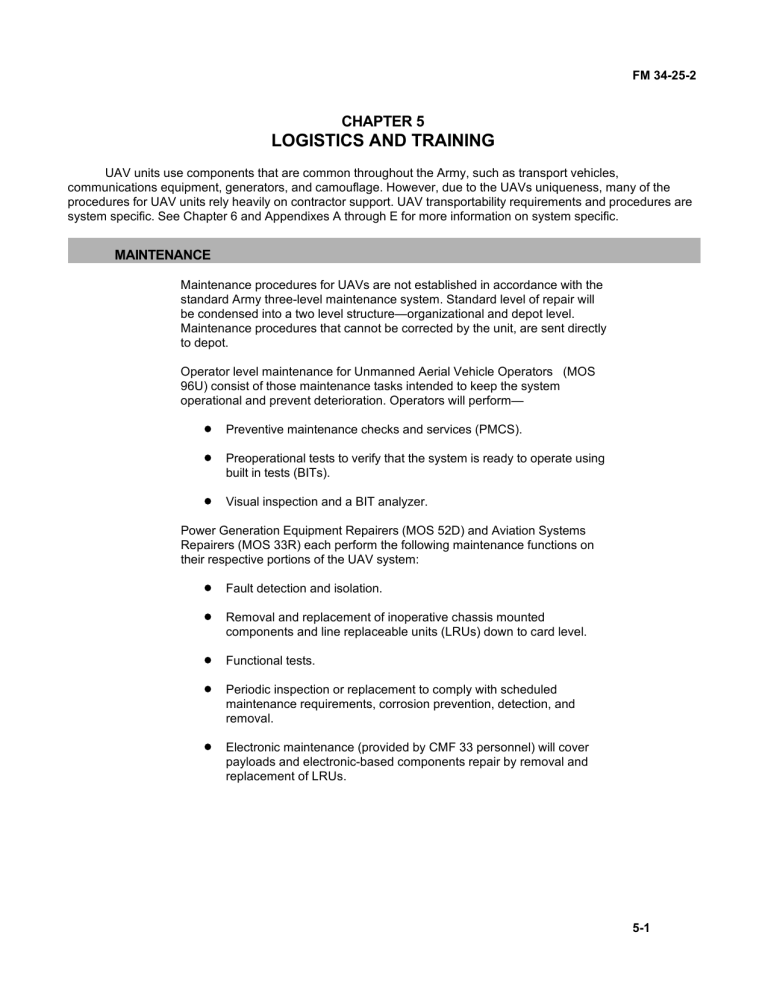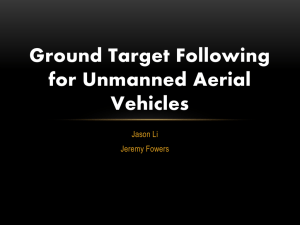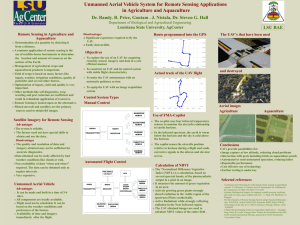LOGISTICS AND TRAINING CHAPTER 5

FM 34-25-2
CHAPTER 5
LOGISTICS AND TRAINING
UAV units use components that are common throughout the Army, such as transport vehicles, communications equipment, generators, and camouflage. However, due to the UAVs uniqueness, many of the procedures for UAV units rely heavily on contractor support. UAV transportability requirements and procedures are system specific. See Chapter 6 and Appendixes A through E for more information on system specific.
MAINTENANCE
Maintenance procedures for UAVs are not established in accordance with the standard Army three-level maintenance system. Standard level of repair will be condensed into a two level structure—organizational and depot level.
Maintenance procedures that cannot be corrected by the unit, are sent directly to depot.
Operator level maintenance for Unmanned Aerial Vehicle Operators (MOS
96U) consist of those maintenance tasks intended to keep the system operational and prevent deterioration. Operators will perform—
Preventive maintenance checks and services (PMCS).
Preoperational tests to verify that the system is ready to operate using built in tests (BITs).
Visual inspection and a BIT analyzer.
Power Generation Equipment Repairers (MOS 52D) and Aviation Systems
Repairers (MOS 33R) each perform the following maintenance functions on their respective portions of the UAV system:
Fault detection and isolation.
Removal and replacement of inoperative chassis mounted components and line replaceable units (LRUs) down to card level.
Functional tests.
Periodic inspection or replacement to comply with scheduled maintenance requirements, corrosion prevention, detection, and removal.
Electronic maintenance (provided by CMF 33 personnel) will cover payloads and electronic-based components repair by removal and replacement of LRUs.
5-1
FM 34-25-2
Intermediate level maintenance personnel in UAV units perform organic tasks intended to repair removed components combining intermediate and organizational levels.
Depot level maintenance personnel perform component repair, part replacement, fault detection, and fault isolation of piece parts.
LOGISTICS
This section describes the combat service support (CSS) necessary to maintain UAV-E in theater and JT-UAV assets operating in corps and division
AO. It outlines responsibilities and identifies the coordination required to support the system.
Unlike many other organizations on the battlefield, when the UAV system is deployed and dispersed geographically across the theater, division, and corps that exist. Figure 5-1 shows the logistic responsibilities for each class of supply.
I
II
III
IV
V
VI
VII
VIII
IX
Class General Support within
AEB or MI Bn Area
AEB or MI Battalion
AEB or MI Battalion
AEB or MI Battalion
AEB or MI Battalion
AEB or MI Battalion
AEB or MI Battalion
AEB or MI Battalion
AEB or MI Battalion
AEB or MI Battalion
Forward Deployed
Elements
Nearest unit provides UAV company and platoon transports.
AEB or MI Battalion
AEB or MI Battalion
AEB or MI Battalion
AEB or MI Battalion
Nearest unit provides.
Common items draw from nearest FSB, when possible,
MI Unique-AEB, or MI
Battalion.
Independent Operations
Supported unit.
Diesel-draw from nearest
FSB, delivered by organic fuel trucks. MOGAS drawn from
AEB or MI Battalion.
AEB or MI Battalion
Supported unit after basic load expires.
Supported unit after basic load expires.
Supported unit after basic load expires.
Supported unit after basic load expires.
Supported unit after basic load expires.
Supported unit or AEB, or
MI Battalion for common items.
Supported unit.
Common items, supported unit MI Unique-
AEB, or MI Battalion.
Figure 5-1. Logistic responsibilities .
Unique Logistical Requirements:
UAV units have the same responsibilities as other units to request and obtain
5-2
FM 34-25-2 supplies and logistics. Because of their uniqueness, they go about it in slightly different ways. The following is a breakdown of unique requirements by class of supply.
Class III . For UAVs this is a complicated class of supply. Most UAV engines currently use motor gasoline (MOGAS).
UAV COMPANY .
One fueler will draw diesel from the AEB whenever possible, or from the forward support base (FSB). Another fueler or vehicle with trailermounted pod must plan to draw MOGAS from the AEB, potentially requiring long hours of driving when the UAV company is dispersed.
UAV PLATOON .
Same as for company, but the source of support is the MI battalion or the FSB.
Class IX . All system peculiar repair parts are delivered to the MI element by MI contact repair teams. When deployed away from the AEB or the MI battalion, the supported unit or FSB provides common items.
TRAINING
The UAV is a valuable battlefield asset. Like any other system, without skilled operators, maintainers, and supervisors, it will not function effectively. To operate and maintain the system effectively, institutional training and unit sustainment training is required for all UAV personnel.
Institutional Training :
A soldier, completing basic training or reclassification, will arrive at the US
Army Intelligence Center and Fort Huachuca for advanced individual training
(AIT). Training is subdivided into UAV Operators (MOS 96U) and Maintenance
Training (MOS 33R and 52D). Soldiers attending the maintenance portion of the UAV training, will have already completed the core MOS 52D AIT at
Aberdeen Proving Grounds, Maryland. Students completing AIT will participate in collective training and an end-of-course field training exercise (FTX).
Institutional training will teach the following MOS 96U tasks at Skill Level 10:
L/R operations.
AV operations.
Payload operations.
Operator level maintenance.
System safety and safety mishap hazard reporting procedures.
Military intelligence tasks include—
— Search techniques.
— Target recognition.
— Indirect fire adjustment.
5-3
FM 34-25-2
— Order of battle (OB).
— C .
— Request, tasking and reporting procedures.
External operator (EO) is at Skill Level 20 and will require additional training, resulting in the award of an additional skill identifier (ASI); key positions of mission coordinator, flight line chief, and data exploitation operator will be taught at the MOS 96U Basic Noncommissioned Officers Course (BNCOC); and UAV system engine repair and maintenance training will be conducted for
MOS 52D soldiers. Leader and supervisor courses will be taught as needed.
Army common training will be used for security tasks, communication tasks, and map reading. Institutional training devices will include—
Ground station simulator.
AV mock-up.
Mission payload mock-up.
Radio controlled model airplanes (standard commercial type).
JT-UAV scale model.
Maintenance simulator.
Unit Sustainment Training :
The unit commander conducts sustainment training to ensure operator proficiency. New equipment training (NET) or other mobile training teams will provide doctrine and TTPs at major command locations during the fielding of systems. The commander then maintains proficiency using FMs and drills containing the doctrine and TTPs.
EO sustainment training is especially critical. The following is a recommended schedule for EO training:
Six hours per week of radio controlled flying.
When it has been 30 days or more since the last UAV flight, the EO should fly for one hour with the scale UAV within 48 hours prior to flying a UAV again. There should also be a one-hour student warm-up flight (in daylight local pattern) with a readiness level-1 (RL-1) EO instructor on the operator box.
When it has been less than 30 days since the last UAV flight, the EO should fly for one hour with the scale UAV within 48 hours prior to flying a UAV.
5-4
CAUTION
Night missions should not be conducted without first flying
a daytime local pattern flight within 48 hours of the night
mission.
The six hours of radio controlled time per week should be broken into one hour of aerobatics, two hours of scale, and three hours of radio controlled flying (depending on weather and runway conditions). One out of every three hours should cover in-flight emergencies, and 30 minutes of each emergency training should be on-site classroom instruction.
Before the first UAV flight of a field exercise, a minimum of one day local flight operations should be conducted to exercise crew proficiency. Detailed flight log and records of operator flight time will be kept to ensure operators maintain proficiency and meet all training requirements.
When no currently proficient EO is available, two EOs can regain proficiency by flying warm-up flights in accordance with training requirements—one acting as instructor, the other as a student.
Two EO boxes will be manned by trained EOs during all UAV flights. The above requirements are waiverable only by the unit's commanding officer. Unit
(sustainment) training devices will include—
Operator proficiency trainer (one per baseline).
Manned surrogate trainer.
Radio controlled model airplanes (standard commercial type).
FM 34-25-2
5-5





